Introduction to Diagnostic Medical Parasitology
Hymenolepiasis
Hymenolepiasis is caused by two species of cestodes: Hymenolepis nana, known as the dwarf tapeworm, has adults measuring 15 to 40 mm in length, while Hymenolepis diminuta, the rat tapeworm, reaches lengths of 20 to 60 cm in adults. Hymenolepis diminuta is a cestode primarily found in rodents and is rarely encountered in humans.
These adults inhabit the ileal portion of the small intestine, where they produce gravid proglottids, typically numbering seven. The eggs are excreted in feces either through the genital atrium of the proglottids or when the proglottids break down in the small intestine. Adult worms have a lifespan of 4 to 6 weeks, but internal autoinfection can allow the infection to persist for years.
Essentials
Hymenolepiasis nana is caused by the dwarf tapeworm, Hymenolepis nana, a very small tapeworm (length up to 4 cm with up to 200 proglottids) living in the small intestine.

Human infections are caused by oral uptake of eggs which contain cysticercoid larvae. In the small intestine, the cysticercoid larva emerges, attaches to the mucosa of the ileum by its scolex and develops. In 3â4 weeks after infection, worms start to oviposit.


Epidemiology
- Distribution is worldwide (more common in warm and dry climates than in cold or wet ones)
- Infection is more common in children
- Infection is acquired through ingestion of eggs in contaminated food or water
- Cestode with direct life cycle (no intermediate hosts)
- Possibility of autoinfection (eggs are already infective when passed in the faeces!)
Pathology
- No pathology in most cases
Clinical Findings
- Infections are usually asymptomatic
- In heavy infections, there might be abdominal pain, weakness, loss of weight and diarrhoea
Diagnosis
Diagnostic methods
Parasitological diagnosis
Diagnosis relies on the detection of ova of H. nana.
Adult worms or proglottids are rarely seen.
Eggs of H. nana are infectious in unpreserved stool samples (infections from person to person)!
Molecular diagnosis
No tests available
Antigen detection
No tests developed so far!
Antibody detection
Serology is without diagnostic value!
Diagnostic strategies
Besides parasitological examinations, no special diagnostic strategy is required!

Prevention and control
- Educate people in personal hygiene and sanitary disposal of faeces